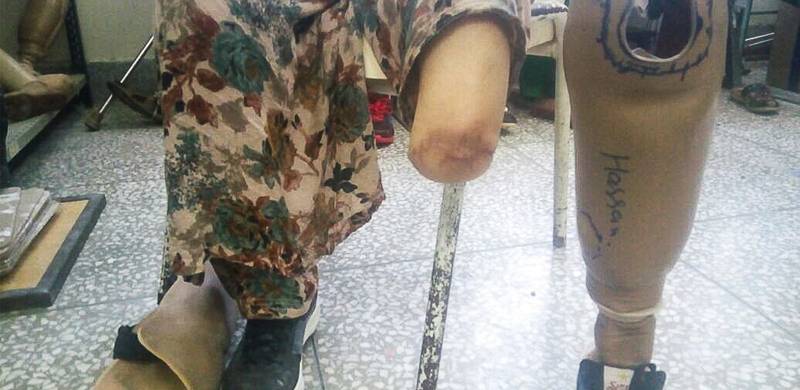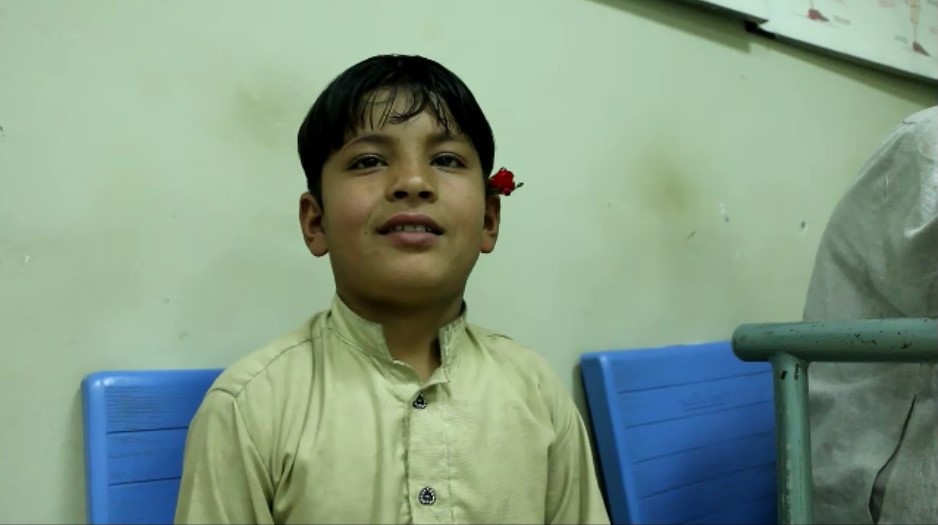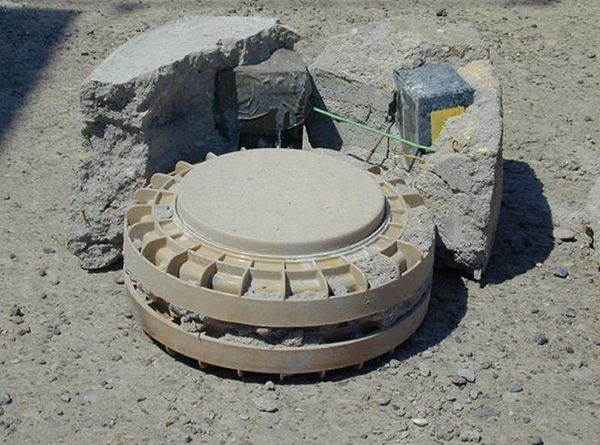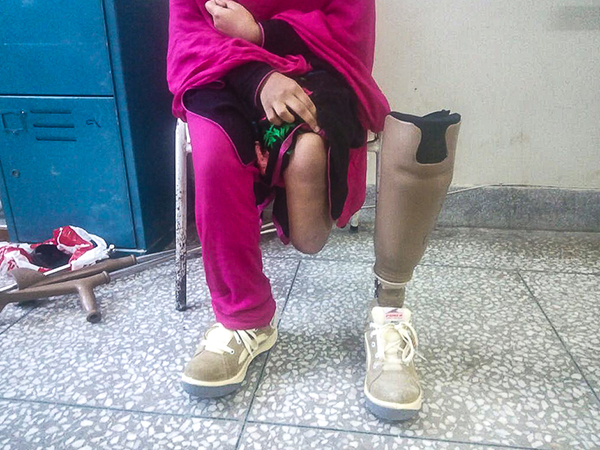
“It was spring 2017 when I returned from school and was playing with my companions when my mother told me to feed the cow in the open fields. 10 minutes later I was lying in the field as my right foot had touched a landmine already planted in the field by miscreants. I didn’t know what had happened but at hospital when I gained consciousness I realized that I had lost one leg in the blast and it was the most tragic and traumatic moment of my life. Whenever I see my companions playing, that incident starts playing in my mind because I can’t play anymore due to my disability”.
This is the story of 11-year-old Naeemullah who hails from Miranshah of North Waziristan. He lost his right leg in a landmine blast in 2017 and is now forced to lead a life of disability.

We conducted interviews in tribal areas with people affected from landmines. Most of them were women or children who had lost their body parts in similar incidents.
After 9/11, the former FATA was engulfed by terrorism and faced enormous miseries due to the militancy first and later migration from their areas due to military operations and now returning to native areas after restoration of peace. Their families and friends repeatedly suffered at the hands of these landmines. There are no proper statistics of landmine victims in KP and adjacent tribal areas but according to the local journalists the number of landmine victims is over 1600 among which 90% are children and women. Repeatedly the civil society organizations as well as the residents of the area demanded a cleanup operation against these landmines, both from civilian and military leadership, but to date no initiatives have been taken to defuse the landmines, planted in thousands, in various districts of tribal areas but South & North Waziristan are the hubs of these mines.
Naeemullah told that his dream was to join the armed forces of Pakistan after intermediate as commissioned officer but now it isn’t possible for him to join as he lost his limb and was unfit for the armed forces.
Sabeel, approximately 9 years of age, lost both hands in a bomb blast and is now completely dependent on the family, from eating food to getting shower. He’s deeply depressed due to the accident. Sharing his painful story, he said that it was an unlucky day of January 2018 when he was returning from school.

“After taking lunch I left home and went to the market nearby for playing with my friend. I found a toy lying there and I was excited for it. My friends were upset that they didn’t find it, while I had. I was unaware that this toy would disable me for life. I came back home and saw my parents and siblings having dinner in the room. They insisted that I join them on dinner but I refused and picked a knife from the kitchen to open its parts. I was pressing that toy with the knife when there was a sudden blast and then I don’t know what happened, but in hospital when I came back to my senses, I found that both my hands were missing. I started crying. My parents and doctors hugged me. They told me I’ll have my hands back someday. But the day hasn’t come as yet.”
According to the media outlets in tribal areas, kids and women from North & South Waziristan were most affected from the landmines and toy bombs. Their numbers are over 300 while the other tribal regions that faced terrorism also have dozens of cases where people lost their lives or faced permanent disabilities.

One example is Bajauar Agency where most of the people, especially women who work in the fields or bring woods for cooking from nearby mountains, are affected by the landmines planted there. According to the statistics by North Waziristan administration, after 2015 more than 105 people died and became disabled in landmine blasts. Most victims are children or women. A large number of animals also died in these blasts.
Gulmena, 38, covered her piercing eyes with a traditional shawl of Pashtun tradition sitting in a local rehabilitation center of Peshawar passed through the tragic pains of life when she lost her whole life in a landmine blast.
“We were sitting in kitchen on a cold evening in Bajaur Agency while taking tea waiting for my father who was running late and the mobile service was not very good in the area to connect us to my father. At that time someone knocked at our door. When we opened the door, my Baba’s dead body was lying there. It had been brought home from hospital as he lost his life in a bomb blast. We lost the sole bread earner of the family in a bomb blast“, Gulmena added with deep pain as tears rolled down her cheeks.

She added that her mother married another man while Gulmena and her brother were left alone. “One day I was on my way to visit a relative in Bajaur area along with my only brother when we were suddenly hit by something. It was a blast and we didn’t realize for a while what had happened. When I came back to my senses I saw that I had lost one leg. But that was not painful enough. Because the next thing I knew was that I had lost my sole brother in the same blast”.
Revealing her pain Mena added that she was young and became disabled so was living with her grandfather and the chances of marrying someone now seemed impossible. I was a burden on my grandfather because he wasn’t able to support me. He had grown old. I went through four surgeries and they made an artificial leg for me as well but it was too heavy for me to walk with”.
A local journalist and social worker from Peshawar working on militancy told Naya Daur on the condition of anonymity that in different areas of the tribal region dozens of people had suffered from landmines, resulting in disabilities and death, and still hundreds of mines are planted in the region. Military operations were conducted in the area but the local military officials or the political administration did nothing to clean up the area of landmines. The promises that they would clean up the area never bore any fruit.
It should be mentioned here that civil rights movement the Pashtun Tahafuz Movement also demands that the area should be made free of landmines.
KP, tribal areas and Balochistan continued to have the highest numbers of mine casualties in Pakistan. These accounted for more than 91 percent of all mine casualties in Pakistan in 2015. Some 132 mine-related casualties were recorded in 2015, of which 32 were due to antipersonnel mines, 73 from anti-vehicles mines, 16 from victim-activated improvised explosive devices (IED), and 11 from explosive remnants of war. In 2014, this number was 233, with more than half of all casualties (57%) being civilians. Among the civilian casualties at least 45 were children. In 2013, 219 such casualties were recorded and 569 in 2011.
PIPOS official Neelum Abdullah told that the center was established in Peshawar to treat and cater needs of persons disabled in bomb blasts and that most of the patients at the center belonged to Afghanistan.
She added that the war on terror was the main source of disabled persons admitted in the center. Moreover, 60% of the patients constitute of women and children effected by war.
Neelum continued that the center was relying heavily on international donors for funds, but ever since they left Pakistan due to contract expiration, PIPOS has found it hard to gather enough resources to treat a lot of people or offer artificial limbs.
The Khyber-Pakhtunkhwa government declared PIPOS autonomous through notification but no funds were received despite continuous requests and applications, she lamented. Neelum also said she was afraid that if the present situation continues, they would have to windup the center.
This is the story of 11-year-old Naeemullah who hails from Miranshah of North Waziristan. He lost his right leg in a landmine blast in 2017 and is now forced to lead a life of disability.

Naeemullah
We conducted interviews in tribal areas with people affected from landmines. Most of them were women or children who had lost their body parts in similar incidents.
After 9/11, the former FATA was engulfed by terrorism and faced enormous miseries due to the militancy first and later migration from their areas due to military operations and now returning to native areas after restoration of peace. Their families and friends repeatedly suffered at the hands of these landmines. There are no proper statistics of landmine victims in KP and adjacent tribal areas but according to the local journalists the number of landmine victims is over 1600 among which 90% are children and women. Repeatedly the civil society organizations as well as the residents of the area demanded a cleanup operation against these landmines, both from civilian and military leadership, but to date no initiatives have been taken to defuse the landmines, planted in thousands, in various districts of tribal areas but South & North Waziristan are the hubs of these mines.
Naeemullah told that his dream was to join the armed forces of Pakistan after intermediate as commissioned officer but now it isn’t possible for him to join as he lost his limb and was unfit for the armed forces.
Sabeel, approximately 9 years of age, lost both hands in a bomb blast and is now completely dependent on the family, from eating food to getting shower. He’s deeply depressed due to the accident. Sharing his painful story, he said that it was an unlucky day of January 2018 when he was returning from school.

Sabeel
“After taking lunch I left home and went to the market nearby for playing with my friend. I found a toy lying there and I was excited for it. My friends were upset that they didn’t find it, while I had. I was unaware that this toy would disable me for life. I came back home and saw my parents and siblings having dinner in the room. They insisted that I join them on dinner but I refused and picked a knife from the kitchen to open its parts. I was pressing that toy with the knife when there was a sudden blast and then I don’t know what happened, but in hospital when I came back to my senses, I found that both my hands were missing. I started crying. My parents and doctors hugged me. They told me I’ll have my hands back someday. But the day hasn’t come as yet.”
According to the media outlets in tribal areas, kids and women from North & South Waziristan were most affected from the landmines and toy bombs. Their numbers are over 300 while the other tribal regions that faced terrorism also have dozens of cases where people lost their lives or faced permanent disabilities.

Picture of an IED taken in Iraq. This is how it looks like.
One example is Bajauar Agency where most of the people, especially women who work in the fields or bring woods for cooking from nearby mountains, are affected by the landmines planted there. According to the statistics by North Waziristan administration, after 2015 more than 105 people died and became disabled in landmine blasts. Most victims are children or women. A large number of animals also died in these blasts.
Gulmena, 38, covered her piercing eyes with a traditional shawl of Pashtun tradition sitting in a local rehabilitation center of Peshawar passed through the tragic pains of life when she lost her whole life in a landmine blast.
“We were sitting in kitchen on a cold evening in Bajaur Agency while taking tea waiting for my father who was running late and the mobile service was not very good in the area to connect us to my father. At that time someone knocked at our door. When we opened the door, my Baba’s dead body was lying there. It had been brought home from hospital as he lost his life in a bomb blast. We lost the sole bread earner of the family in a bomb blast“, Gulmena added with deep pain as tears rolled down her cheeks.

She added that her mother married another man while Gulmena and her brother were left alone. “One day I was on my way to visit a relative in Bajaur area along with my only brother when we were suddenly hit by something. It was a blast and we didn’t realize for a while what had happened. When I came back to my senses I saw that I had lost one leg. But that was not painful enough. Because the next thing I knew was that I had lost my sole brother in the same blast”.
Revealing her pain Mena added that she was young and became disabled so was living with her grandfather and the chances of marrying someone now seemed impossible. I was a burden on my grandfather because he wasn’t able to support me. He had grown old. I went through four surgeries and they made an artificial leg for me as well but it was too heavy for me to walk with”.
A local journalist and social worker from Peshawar working on militancy told Naya Daur on the condition of anonymity that in different areas of the tribal region dozens of people had suffered from landmines, resulting in disabilities and death, and still hundreds of mines are planted in the region. Military operations were conducted in the area but the local military officials or the political administration did nothing to clean up the area of landmines. The promises that they would clean up the area never bore any fruit.
It should be mentioned here that civil rights movement the Pashtun Tahafuz Movement also demands that the area should be made free of landmines.
KP, tribal areas and Balochistan continued to have the highest numbers of mine casualties in Pakistan. These accounted for more than 91 percent of all mine casualties in Pakistan in 2015. Some 132 mine-related casualties were recorded in 2015, of which 32 were due to antipersonnel mines, 73 from anti-vehicles mines, 16 from victim-activated improvised explosive devices (IED), and 11 from explosive remnants of war. In 2014, this number was 233, with more than half of all casualties (57%) being civilians. Among the civilian casualties at least 45 were children. In 2013, 219 such casualties were recorded and 569 in 2011.
PIPOS official Neelum Abdullah told that the center was established in Peshawar to treat and cater needs of persons disabled in bomb blasts and that most of the patients at the center belonged to Afghanistan.
She added that the war on terror was the main source of disabled persons admitted in the center. Moreover, 60% of the patients constitute of women and children effected by war.
Neelum continued that the center was relying heavily on international donors for funds, but ever since they left Pakistan due to contract expiration, PIPOS has found it hard to gather enough resources to treat a lot of people or offer artificial limbs.
The Khyber-Pakhtunkhwa government declared PIPOS autonomous through notification but no funds were received despite continuous requests and applications, she lamented. Neelum also said she was afraid that if the present situation continues, they would have to windup the center.
